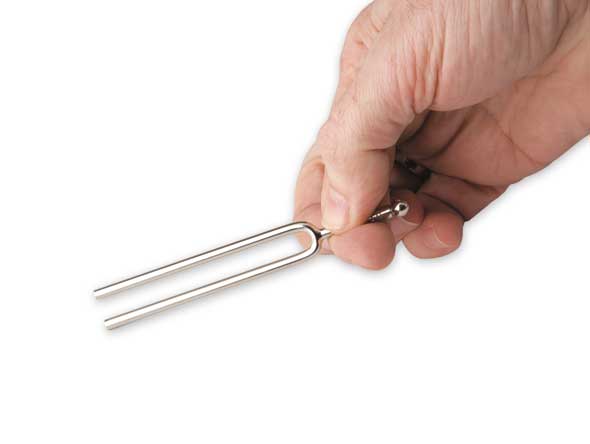
Tuning the Guitar to a Tuning Fork
Tuning your guitar to a tuning fork is one of the least expensive methods of ensuring your guitar will be at concert pitch. A tuning fork is a small metal object in the shape of a fork that is hit against something solid and placed on the bridge or soundboard of the guitar producing a note that the first string can be tuned to.
The other strings are then tuned to the 1st string. The most common tuning fork is an A tuning fork that gives the note A on the 5th fret of the first string. An E tuning fork is also available which produces the note of the open 1st string (E).

Tuning Fork

Strike Tuning Fork

Place Tuning Fork on Guitar
Step 1 Tuning the 1st String to the Tuning Fork
Play either the open 1st string (E), or the fifth fret of the 1st string (A) depending on which tuning fork you have. Immediately after picking the string strike the tuning fork against something solid and place the fork on the bridge of the guitar. Compare the pitch of the string and the sound produced by the tuning fork.
If the pitch of the tuning fork sounds the same as the note you played on the 1st string the string is in tune. If the 1st string sounds higher, it means that it is sharp. Turn the tuning key slowly in a clockwise direction therefore lowering the pitch of the note. If the 1st string sounds lower, it means that it is flat. Turn the tuning key slowly in a counter-clockwise direction to raise the pitch of the note.
Step 2 Tuning the 2nd String to the 1st String
The next step is to tune the rest of the strings to the 1st string. This is done in the same way as tuning the guitar to itself, as explained on the previous pages, except the strings are tuned in the reverse order. Place a left hand finger on the 2nd string at the fifth fret, and play the string.
Play the open 1st string. This time you will need to tune the 2nd string to the pitch of the 1st string. Turn the tuning key for the 2nd string in the correct direction, as explained in step 1, until the note on the fifth fret of the 2nd string (E) is the same as the open 1st string (E).
Step 3 Tuning the 3rd String to the 2nd String
Place a left hand finger on the 3rd string at the 4th fret, and play the string. Play the open 2nd string. Adjust the tuning key for the 3rd string until the note on the fourth fret of the 3rd string (B) is the same as the open 2nd string (B).
Step 4 Tuning the 4th String to the 3rd String
Place a left hand finger on the 4th string at the 5th fret, and play the string. Play the open 3rd string. Adjust the tuning key for the 4th string until the note on the fifth fret of the 4th string (G) is the same as the open 3rd string (G).
Step 5 Tuning the 5th String to the 4th String
Place a left hand finger on the 5th string at the 5th fret, and play the string. Play the open 4th string. Adjust the tuning key for the 5th string until the note on the fifth fret of the 5th string (D) is the same as the open 4th string (D).
Step 6 Tuning the 6th String to the 5th String

Finally place a left hand finger on the 6th string at the 5th fret, and play the string. Play the open 5th string. Adjust the tuning key for the 6th string until the note on the fifth fret of the 6th string (A) is the same as the open 5th string (A). This step and each of the previous steps can be shown in the adjacent diagram.